Ann Husband, known as Agnes, was a suffragette, social reformer and one of Dundee’s first female councillors. Husband spent a significant part of her life working to improve the care and education of children, and pressed for a humane approach to supporting the poor. By tracing Husband through our records, we can build a picture of her family and life.
Early Life
Born in the Parish of Ferry Port on Craig, or Tayport, Husband was the eldest daughter of John Husband and Agnes née Lamond or Lomand. Interestingly, many secondary sources record Husband’s birthday as 20 May 1852. Returning to the primary source, her entry in the Old Parish Registers, we can see that this is actually the date of her baptism.
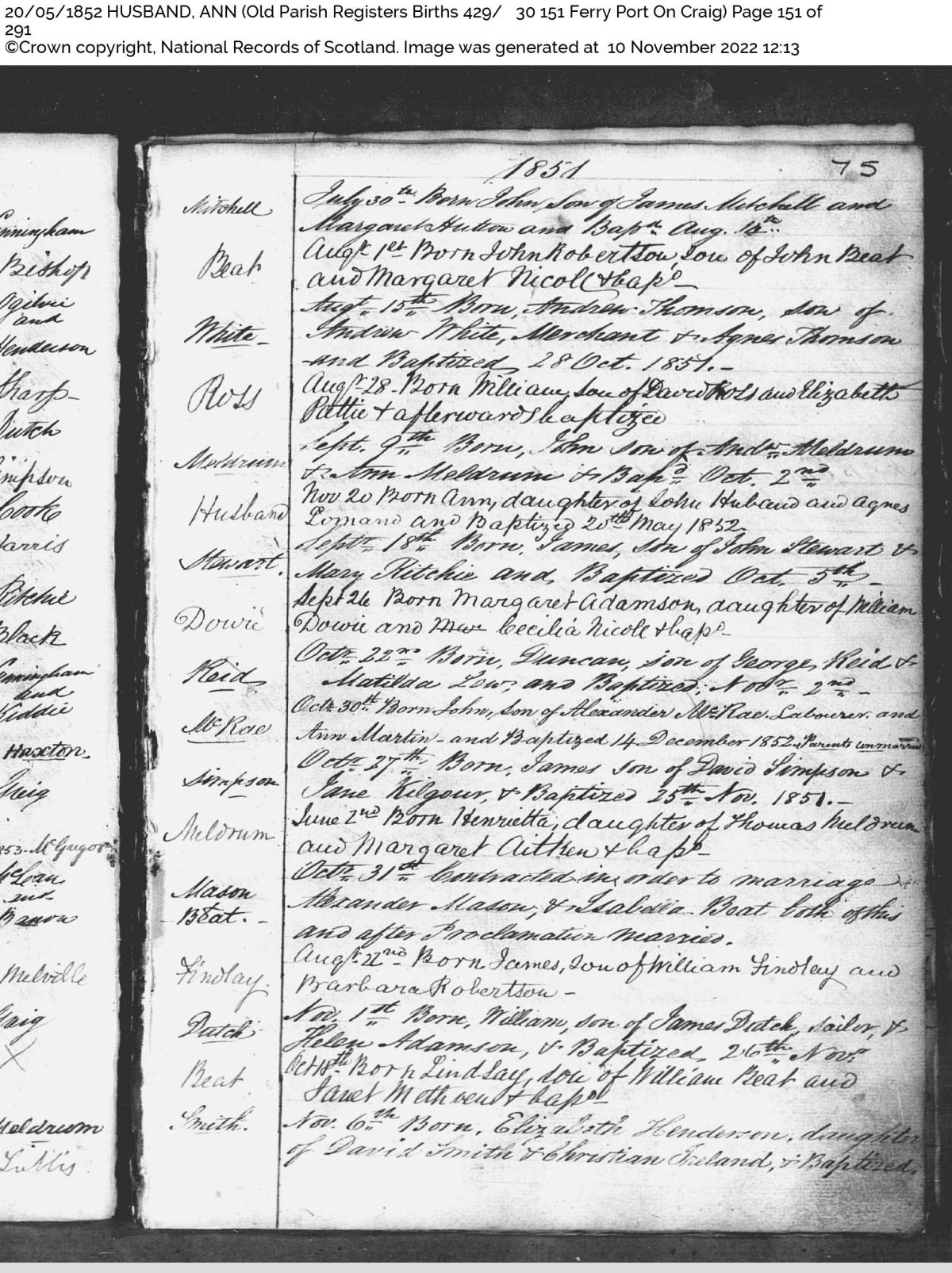

Her birth date was 20 November 1851.
The late baptism of Husband could be for a number of reasons. Her father’s occupation as a sailor, and eventual master mariner, may explain the delay. We can speculate that the family may have waited for him to return home before registering the child.
Through the records of the Scottish census we can trace both Husband, and the development of her family over the decades.
Through the records
Census records provide a snapshot, recording who was present in a residence on a particular date and time. In 1861 the family were in the Parish of Ferry Port on Craig, or Tayport, and are enumerated at 192 Dalgleish Street. Agnes Husband is 9 years old and now has three younger sisters and a younger brother. The head of the family, John Husband, is away from home. Her mother is recorded as a ‘Sailor’s wife’.

Crown copyright, National Records of Scotland, 429/1 page 31
In 1871 the family have moved and now live at 18 Craig Road. The head of the family, John Husband, is present and his occupation is recorded as a ‘Shipmaster’. Agnes Husband’s occupation is listed as a ‘milliner’.

Crown copyright, National Records of Scotland, 429/2 page 3
In 1881 and 1891, Husband is no longer in Scotland. In 1881 she is enumerated in the English census at 32 Rokeby Park, County Durham. A large estate that still exists today, Husband is enumerated working as a Lady’s maid. In 1891, she appears in the English Census again, this time at 21 Gladstone terrace, Battersea, London. Husband is one of several visitors, presumably staying with friends, and is recorded as a Dressmaker and employer.
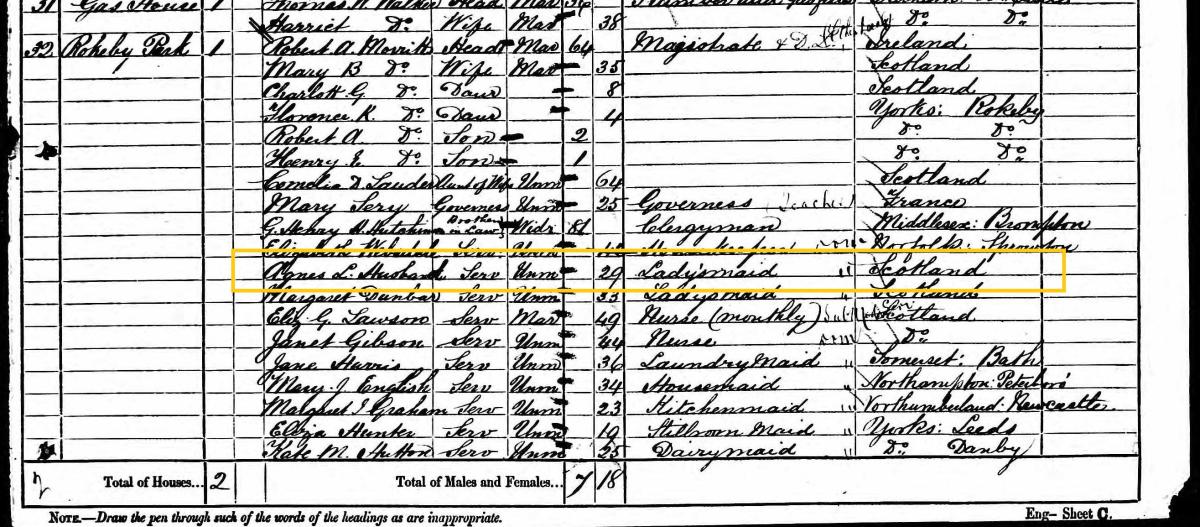
TNA, RG11/4934

TNA, RG12/423
It is likely through necessity that Husband developed her skills in sewing and millinery. In an interview published in The Vote, 8 October 1920, she reflects:
“The Universities had not yet been opened to women, and a girl who had to earn her living had no choice except needlework. This, therefore, became my means of livelihood, and after our parents’ death my sister and I joined together in a business of our own, which, from our own, not the accepted point of view, has been until now a quite satisfactory venture”.
Agnes and her sister Catherine continued in business as ‘Dress or Mantle maker[s]’ for many years. In the 1901 Scottish census, they are enumerated together at 107 Murraygate, Dundee. Agnes is the Head of the household and in the same building are her sisters Catherine, Wilhelmina, and her niece, Catherine.

Crown copyright, National Records of Scotland, 282/3/8 page 2
Later Life
It was through the Labour movement that Husband became familiar with local politics and the importance of a woman’s position legally and socially (Vote, 8 October 1920). In 1901 she became one of the first of two women elected to the Dundee Parish Council (with Mary Lily Walker). She had stood several times unsuccessfully, but once elected, served dutifully until 1928.
At this point the thread of Husband’s life through the census disappears; both her and her sister Catherine seem to be missing from the 1911. While it is possible to trace Catherine Husband in the 1921 census to the parish of Forgan - where she appears to be visiting friends in the Rowbottom family - Agnes' location is less certain.
One ‘Anges’ Husband appears, age 67, in the parish of Edinburgh at 13 Stanley Road. Enumerated as a visitor, her birthplace is recorded as ‘Tayport Fife’. The age is incorrect, but this could be an error by the enumerator or by Husband. However, the occupation is recorded as ‘Home Duties’. Given that past censuses accurately record Husband’s profession it seems unlikely that this is the Agnes Husband we are seeking.
In the Valuation Roll for 1895 both Agnes and Catherine are recorded under 67 Murraygate, in a building described as ‘Dwelling houses and work-rooms’. Using the Post Office Directories, we find the sisters listed in the Murraygate area until at least 1912. This area featured predominately commercial properties. It is possible that the enumerator assumed the buildings were purely commercial and lacking inhabitants. If Husband was at home, it seems she was likely missed by mistake.
“The people’s tribune and children’s friend”
In 1905 Husband was elected to the Dundee School Board where she promoted better education and care for children. She argued for free books and meals. We also know that she worked on several committees concerned with education, health and young people.
In 1904 Husband attended the inaugural meeting of the Dundee Women’s Suffrage Society, and, two years later, joined the Women’s Social and Political Union (WSPU). In 1909 she became the president of the Dundee Women’s Freedom League (WFL) branch. Given Husband’s regard for democratic meetings and campaigning, it is possible that her switch to the WFL was to remove herself from the increasingly autocratic rule of the Pankhursts over the WSPU. After the First World War, Husband went on to participate in the executive committee of the Dundee Women Citizen’s Association.
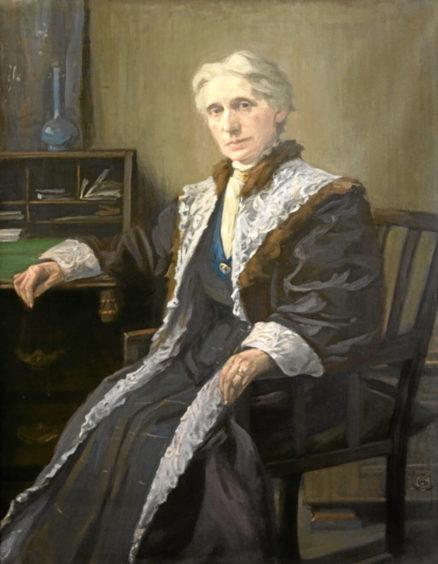
Image courtesy of Dundee Art Galleries and Museums
A portrait of Agnes Husband by Alec Grieve was gifted to the Dundee Picture Gallery, now The McManus, in 1910. The gift was in recognition of Husband’s contribution to the community over 20 years. The newspapers record that amongst those that organised the presentation were: the Poor Children’s Holiday Home Workers, members of the Social Union, the Women’s Enfranchise Movement, the Labour Party and the Educational Associations of Dundee (Dundee Evening Telegraph, 23 June 1910).
The presentation of the portrait was accompanied by a poem dedicated to Husband by John Ogilvie:
“So truth finds speech, and names you for a prize.
My Splendid sister, pitiful and wise,
In you we see th’ intrepid pioneer
Of holy purpose and of vision clear.
Heedless of hate and purblind critic-scorn,
You take the path were tender feet are torn.
And smite the sin that, selfishly secure,
Out-shrieks the pale protestings of the poor.
We love you for your wealth of cultured mind,
And patient heart, and spirit hot but kind,
And dauntless faith, and grey, inspiring eyes,
And saint-like calm, and wayside ministries,
And swift attachment to the common cause,
And brace disdain of popular applause.
We love you, and will love you to the end,
The people’s tribune and the children’s friend”.
(printed in the Dundee Evening Telegraph, 15 July 1910)
After the passage into law of the Sex Disqualification (Removal) Act, it was concluded that women should be added to the Commission of the Peace. For this purpose, women were selected based on distinguished public service, or according to one newspaper report, “possession of exceptional private gifts” (Dundee Courier, 20 July 1920). Agnes Husband became the first woman Justice of the Peace for Dundee.
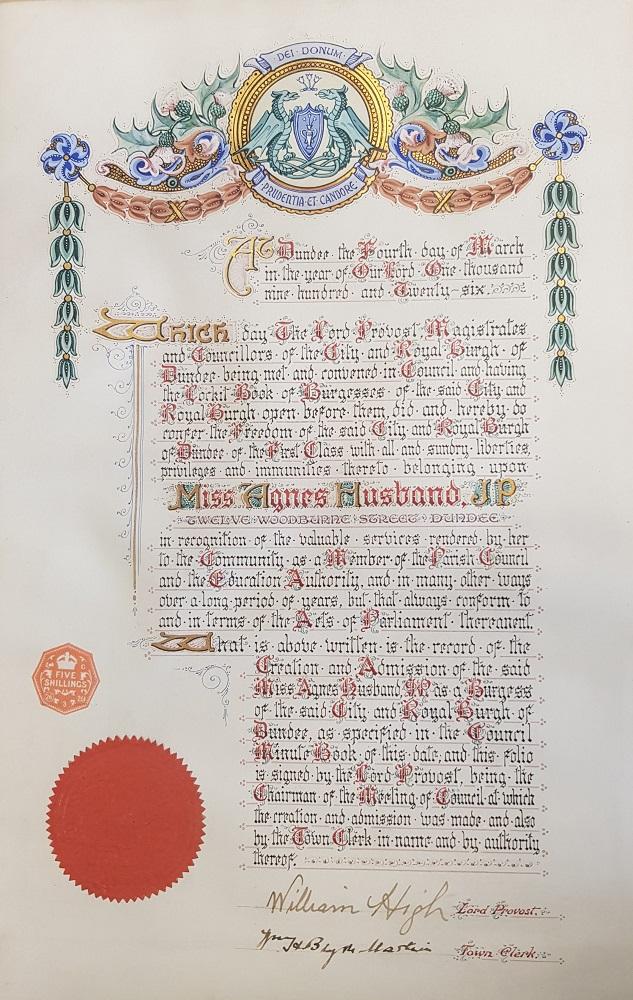
Image courtesy of Dundee City Archives
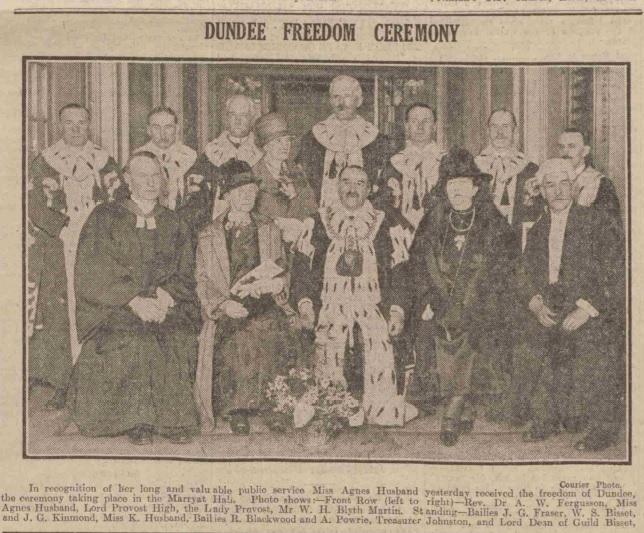
Image courtesy of DC Thomson & Co Ltd.
In 1926 Husband became the fifth woman to be given the freedom of the city. A fitting tribute to her long and valuable public service.
Agnes Husband is commemorated in Dundee with a plaque and inclusion in the Dundee Women’s Trail. Her contribution to public service was most recently distinguished with the naming of Agnes Husband House. A new building on Dundee’s waterfront and current home to Social Security Scotland.
Agnes Husband passed away on 15 April 1929 at 2 Crombie Terrace, Craigiebank Dundee.
Sources/Further Reading
• Dundee City Archives
• National Records of Scotland:
• Old Parish Registers
• Scottish Census Records
• Valuation Rolls
• National Library of Scotland, Post Office Directories
• British Newspaper Archive, www.britishnewspaperarchives.co.uk
• The Vote, 8 October 1920
• Dundee Evening Telegraph, 23 June 1910
• Dundee Evening Telegraph, 15 July 1910
• Dundee Courier, 20 July 1920).
• The Biographical Dictionary of Scottish Women, Edited by Elizabeth Ewan, Sue Innes, Sian Reynolds. Co-ordinating Editor, Rose Pipes
• A Guid Case: The Women’s Suffrage Movement in Scotland, Leah Leneman